经济学术语
常见经济术语及解释

常用经济名词解释汇编1、宏观调控:是国家对国民经济总量进行的调节与控制,是保证社会再生产协调发展的必要条件,也是社会主义国家管理经济的重要职能。
在中国,宏观调控的主要任务是:保持经济总量平衡,抑制通货膨胀,促进重大经济结构优化,实现经济稳定增长。
宏观调控主要运用价格、税收、信贷、汇率等经济手段和法律手段以及行政手段。
2、扩大内需:就是在生产相对过剩的情况下,调整经济结构(包括生产结构和消费结构),拓宽国际市场。
培育消费热点,以拉动经济的增长。
简言之,就是通过扩大投资需求和消费需求来拉动经济增长。
扩大内需必须实行积极的财政政策,稳健的货币政策和正确的消费政策。
3、经济周期:也称商业周期、景气循环,它是指经济运行中周期性出现的经济扩张与经济紧缩交替更迭、循环往复的一种现象。
是国民总产出、总收入和总就业的波动,是国民收入或总体经济活动扩张与紧缩的交替或周期性波动变化。
过去把它分为繁荣、衰退、萧条和复苏四个阶段,现在一般叫做衰退、谷底、扩张和顶峰四个阶段。
4、社会总产值:是指一定时期内(通常为1年)以货币表现的农业、工业、建筑业、运输邮电业和商业(包括饮食业和物资供销业)五大物质生产部门的总产值之和,也称社会总产品。
它是反映一个国家或地区在一定时期内物质生产总成果的重要指标。
它与国民生产总值不同之处在于,除了理论基础不同外,计算的范围和方法不同。
社会总产值是包括物耗在内的社会产品的总价值,而国民生产总值只是新增加的价值。
社会总产值只包括物质生产部门,而国民生产总值则包括非物质生产部门在内的国民经济各个部门。
5、GNP:英文Gross National Product的缩写,也就是国民生产总值,是指一个国家(地区)所有常住机构单位在一定时期内(年或季)收入初次分配的最终成果。
一个国家常住机构单位从事生产活动所创造的增加值(国内生产总值)在初次分配过程中主要分配给这个国家的常住机构单位,但也有一部分以劳动者报酬和财产收入等形式分配给该国的非常住机构单位。
经济学常用词汇英文

经济学常用英语词汇一、一般术语英文中文economist经济学家scarcity稀缺性opportunity cost机会成本marginal边际的utility效用efficiency效率equity公平trade-off权衡incentive激励externality外部性二、经济体系英文中文socialist economy社会主义经济capitalist economy资本主义经济collective economy集体经济planned economy计划经济market economy市场经济mixed economy混合经济liberal economy自由经济protectionism保护主义autarchy闭关自守globalization全球化三、经济学分支英文中文microeconomics微观经济学macroeconomics宏观经济学political economy政治经济学development economics发展经济学international economics国际经济学labor economics劳动经济学environmental economics环境经济学英文中文industrial economics工业经济学public economics公共经济学behavioral economics行为经济学四、市场结构英文中文perfect competition完全竞争monopoly垄断oligopoly寡头垄断monopolistic competition垄断竞争duopoly双寡头cartel卡特尔collusion勾结price discrimination价格歧视price leadership价格领导contestable market可竞争市场五、供求理论英文中文demand需求supply供给equilibrium均衡surplus过剩shortage不足elasticity弹性price elasticity of demand需求价格弹性income elasticity of demand需求收入弹性cross elasticity of demand需求交叉弹性price elasticity of supply供给价格弹性六、成本收益分析英文中文cost成本benefit收益total cost总成本fixed cost固定成本variable cost可变成本average cost平均成本marginal cost边际成本total revenue总收入average revenue平均收入marginal revenue边际收入七、国际贸易英文中文trade贸易export出口import进口tariff关税quota配额subsidy补贴exchange rate汇率balance of trade贸易差额balance of payments国际收支comparative advantage比较优势八、货币银行英文中文money货币currency货币bank银行deposit存款loan贷款interest利息interest rate利率inflation通货膨胀deflation通货紧缩monetary policy货币政策九、财政政策英文中文fiscal policy财政政策budget预算revenue收入expenditure支出tax税income tax所得税value added tax增值税sales tax销售税budget deficit预算赤字budget surplus预算盈余十、经济指标英文中文gross domestic product国内生产总值gross national product国民生产总值national income国民收入per capita income人均收入unemployment失业unemployment rate失业率economic growth经济增长economic development经济发展business cycle经济周期recession衰退。
经济学名词解释
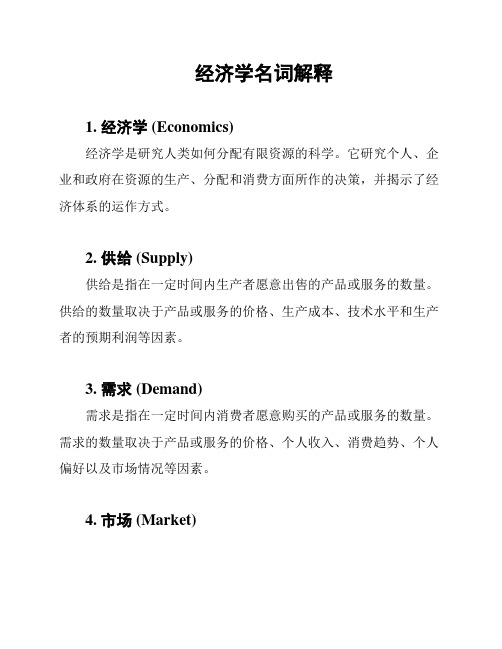
经济学名词解释1. 经济学 (Economics)经济学是研究人类如何分配有限资源的科学。
它研究个人、企业和政府在资源的生产、分配和消费方面所作的决策,并揭示了经济体系的运作方式。
2. 供给 (Supply)供给是指在一定时间内生产者愿意出售的产品或服务的数量。
供给的数量取决于产品或服务的价格、生产成本、技术水平和生产者的预期利润等因素。
3. 需求 (Demand)需求是指在一定时间内消费者愿意购买的产品或服务的数量。
需求的数量取决于产品或服务的价格、个人收入、消费趋势、个人偏好以及市场情况等因素。
4. 市场 (Market)市场指的是买卖商品和服务的地方、机构或机制。
在市场中,供给者和需求者通过买卖来交换产品和服务,从而形成价格和数量的协商。
5. 垄断 (Monopoly)垄断是指市场上只有一个唯一的供应者或销售者,他们掌握着市场的全部权力。
这使得垄断者能够控制产品或服务的价格,并对市场产生影响。
6. 通货膨胀 (Inflation)通货膨胀是指一段时间内货币供应量超过实际经济需求,导致货币的购买力下降。
通货膨胀通常伴随着物价上涨,对经济活动和消费者行为产生重大影响。
7. 货币政策 (Monetary Policy)货币政策由中央银行制定和实施,旨在控制货币供应量和利率水平,以影响经济总体表现和稳定物价。
货币政策可以通过调整利率、做市操作和定向准备金等手段来实施。
8. 贸易 (Trade)贸易是指不同国家或地区之间购买和出售商品和服务的交换活动。
贸易可以促进国际间资源的配置和经济增长,并且有助于加强国际间的经济合作与互动。
9. GDP (Gross Domestic Product)国内生产总值 (Gross Domestic Product, GDP) 是指一个国家或地区在一定时间内生产的全部最终产品和服务的市场价值。
GDP被视为衡量一个国家经济活动和增长的重要指标。
10. 通货紧缩 (Deflation)通货紧缩是指货币供应量不足以满足实际经济需求,导致货币的购买力上升。
经济学英语词汇大全了解经济学理论与经济现象的专业术语

经济学英语词汇大全了解经济学理论与经济现象的专业术语经济学是一门研究人类在稀缺资源下进行资源配置和决策的社会科学。
在经济学领域,有许多专业术语用于描述不同的理论和经济现象。
以下是一份经济学英语词汇大全,将帮助你更好地了解经济学理论和经济现象。
一、宏观经济学术语1. Gross Domestic Product (GDP): 国内生产总值,用于衡量一个国家或地区在一定时间内生产的全部最终商品和服务的市场价值。
2. Inflation: 通货膨胀,衡量物价持续上涨的速度。
3. Unemployment Rate: 失业率,某国或地区的劳动力中未有工作的比例。
4. Fiscal Policy: 财政政策,指政府通过调整税收和支出来影响经济发展的政策。
5. Monetary Policy: 货币政策,指央行通过调整货币供应量和利率来控制通胀和经济增长的政策。
二、微观经济学术语1. Supply and Demand: 供求关系,描述市场上商品和服务的供给和需求关系,决定价格和数量。
2. Price Elasticity of Demand: 需求的价格弹性,衡量消费者对价格变化的敏感程度。
3. Utility: 效用,消费者对商品或服务的满意程度。
4. Market Failure: 市场失灵,指市场机制无法有效配置资源的情况,需要政府干预。
5. Opportunity Cost: 机会成本,指做出某个选择而放弃的最好的替代选择。
三、国际经济学术语1. Trade Deficit: 贸易逆差,指一个国家或地区的进口超过出口的差额。
2. Exchange Rate: 汇率,用于衡量一种货币与其他货币之间的相对价值。
3. Tariff:关税,进口商品需要缴纳的税费。
4. Comparative Advantage: 比较优势,指某国在生产某种商品或服务上相对于其他国家的优势。
5. Foreign Direct Investment (FDI): 外商直接投资,指投资者将资金投资到其他国家的生产或商业项目中。
常见经济学名词汇总
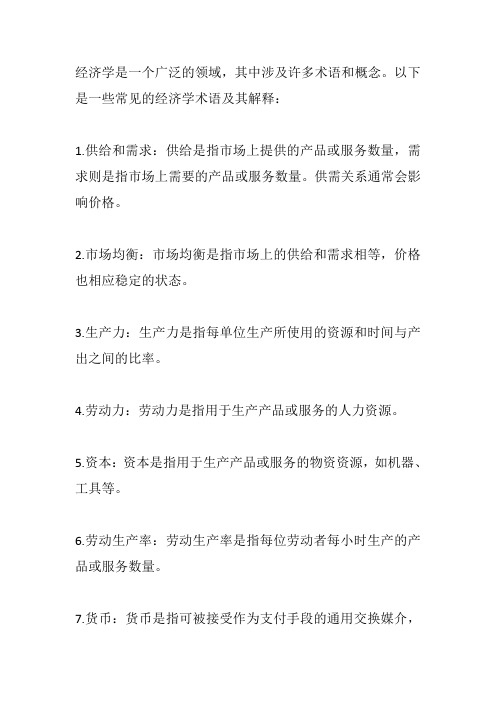
经济学是一个广泛的领域,其中涉及许多术语和概念。
以下是一些常见的经济学术语及其解释:1.供给和需求:供给是指市场上提供的产品或服务数量,需求则是指市场上需要的产品或服务数量。
供需关系通常会影响价格。
2.市场均衡:市场均衡是指市场上的供给和需求相等,价格也相应稳定的状态。
3.生产力:生产力是指每单位生产所使用的资源和时间与产出之间的比率。
4.劳动力:劳动力是指用于生产产品或服务的人力资源。
5.资本:资本是指用于生产产品或服务的物资资源,如机器、工具等。
6.劳动生产率:劳动生产率是指每位劳动者每小时生产的产品或服务数量。
7.货币:货币是指可被接受作为支付手段的通用交换媒介,通常以现金或数字形式存在。
8.通货膨胀:通货膨胀是指货币供应量增加,导致物价上涨的现象。
9.利率:利率是指借贷资金的费用,通常以百分比形式表示。
10.税收:税收是政府从居民和企业收取的针对所得、消费、财产等形式的收入。
11.财政政策:财政政策是指政府通过预算支出和税收来影响经济的政策。
12.货币政策:货币政策是指央行通过利率、货币供应量等手段来影响经济的政策。
13.经济周期:经济周期是指经济活动的波动,包括经济增长、衰退、复苏等阶段。
14.失业率:失业率是指劳动力中没有工作的人口比例。
15.经济增长:经济增长是指一个国家或地区在一定时间内生产总值的增长。
16.生产总值:生产总值是指一个国家或地区在一定时间内所生产的所有产品和服务的总价值。
17.市场结构:市场结构是指市场中公司数量和市场份额的分布情况,通常包括垄断、寡头垄断、竞争等类型。
18.外汇:外汇是指一种货币与其他货币的汇率关系。
19.国际贸易:国际贸易是指一个国家与其他国家之间的商品和服务的进出口。
20.全球化:全球化是指各国之间经济、政治和文化联系不断增强,形成一个越来越紧密的全球化社会。
21.市场失灵:市场失灵是指市场无法有效分配资源或产生不公平的结果,需要政府或其他机构介入进行调节。
经济类常用术语
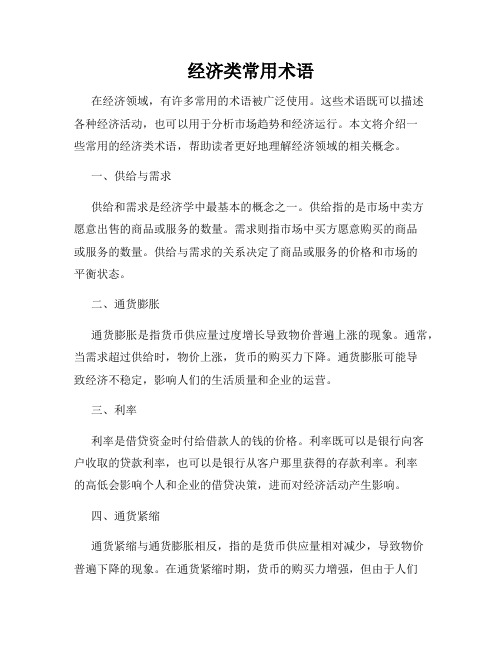
经济类常用术语在经济领域,有许多常用的术语被广泛使用。
这些术语既可以描述各种经济活动,也可以用于分析市场趋势和经济运行。
本文将介绍一些常用的经济类术语,帮助读者更好地理解经济领域的相关概念。
一、供给与需求供给和需求是经济学中最基本的概念之一。
供给指的是市场中卖方愿意出售的商品或服务的数量。
需求则指市场中买方愿意购买的商品或服务的数量。
供给与需求的关系决定了商品或服务的价格和市场的平衡状态。
二、通货膨胀通货膨胀是指货币供应量过度增长导致物价普遍上涨的现象。
通常,当需求超过供给时,物价上涨,货币的购买力下降。
通货膨胀可能导致经济不稳定,影响人们的生活质量和企业的运营。
三、利率利率是借贷资金时付给借款人的钱的价格。
利率既可以是银行向客户收取的贷款利率,也可以是银行从客户那里获得的存款利率。
利率的高低会影响个人和企业的借贷决策,进而对经济活动产生影响。
四、通货紧缩通货紧缩与通货膨胀相反,指的是货币供应量相对减少,导致物价普遍下降的现象。
在通货紧缩时期,货币的购买力增强,但由于人们预期物价将进一步下降,消费和投资意愿可能会下降,从而抑制经济增长。
五、贸易逆差和贸易顺差贸易逆差指的是一个国家的进口超过了出口,即出现了贸易赤字。
相反,贸易顺差则意味着一个国家的出口超过了进口,即出现了贸易盈余。
贸易逆差和贸易顺差可以反映一个国家的国际收支状况和经济竞争力。
六、经济增长经济增长是指一个国家或地区的总体经济活动的增加。
经济增长通常以国内生产总值(GDP)的增长率来衡量。
经济增长可以带来就业机会增加,人民生活水平提高,但也可能导致资源过度利用和环境问题。
七、劳动力市场劳动力市场指的是供给和需求劳动力的市场。
供给方是寻找就业机会的劳动力,需求方则是提供就业机会的企业和机构。
劳动力市场的状况影响着就业率和工资水平,对经济的发展和社会稳定具有重要意义。
八、经济政策经济政策是由政府制定和实施的旨在调整经济发展的政策措施。
常见的经济政策包括财政政策、货币政策和产业政策等。
100个经济学术语
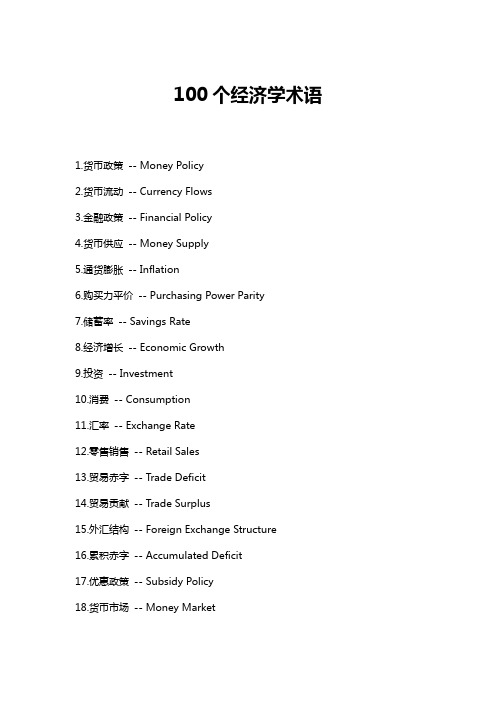
100个经济学术语1.货币政策-- Money Policy2.货币流动-- Currency Flows3.金融政策-- Financial Policy4.货币供应-- Money Supply5.通货膨胀-- Inflation6.购买力平价-- Purchasing Power Parity7.储蓄率-- Savings Rate8.经济增长-- Economic Growth9.投资-- Investment10.消费-- Consumption11.汇率-- Exchange Rate12.零售销售-- Retail Sales13.贸易赤字-- Trade Deficit14.贸易贡献-- Trade Surplus15.外汇结构-- Foreign Exchange Structure16.累积赤字-- Accumulated Deficit17.优惠政策-- Subsidy Policy18.货币市场-- Money Market19.社会保障-- Social Security20.社会风险-- Social Risk21.财政税收-- Fiscal Taxation22.银行业监管-- Banking Supervision23.国际收支-- Balance of International Payments24.国际贸易-- International Trade25.负债-- Debt26.投机-- Speculation27.货币贬值-- Currency Devaluation28.汇率监管-- Exchange Rate Control29.汇率波动-- Exchange Rate Fluctuations30.量化宽松-- Quantitative Easing31.财政补贴-- Fiscal Subsidies32.机会成本-- Opportunity Cost33.市场价格-- Market Pricing34.资金流动-- Fund Flows35.效用-- Utility36.经济因素-- Economic Factors37.消费者支出-- Consumer Expenditures38.收入分配-- Income Distribution39.关税-- Tariffs40.经济政策-- Economic Policy41.欧盟-- European Union42.可支配收入-- Disposable Income43.经济学模型-- Economic Models44.利率-- Interest Rate45.技术创新-- Technological Innovation46.信用-- Credit47.经济结构-- Economic Structure48.现金流量-- Cash Flow49.竞争-- Competition50.财政支出-- Fiscal Expenditure51.金融改革-- Financial Reform52.非货币政策-- Non-monetary Policy53.贷款-- Loans54.市场需求-- Market Demand55.需求分析-- Demand Analysis56.汇率-- Exchange Rate57.负债率-- Debt to Equity Ratio58.波动性-- Volatility59.消费者保价-- Consumer Price Index60.货币开支-- Monetary Expenditures61.物价指数-- Price Index62.调整-- Adjustment63.预算不平衡-- Budget Imbalance64.全球经济-- Global Economy65.投资风险-- Investment Risk66.汇率风险-- Exchange Rate Risk67.财政失衡-- Fiscal Imbalance68.碳排放税-- Carbon Tax69.补贴-- Subsidy70.储备货币-- Reserve Currency71.零利率政策-- Zero Interest Policy72.泡沫经济-- Bubble Economy73.货币结构-- Monetary Structure74.国际衡平-- International Equilibrium75.社会运动-- Social Movements76.商业循环-- Business Cycle77.物价水平-- Price Level78.生产力-- Productivity79.竞争环境-- Competitive Environment80.间接税-- Indirect Taxes81.舶来税-- Tariff82.社会失业-- Social Unemployment83.进出口-- Imports and Exports84.金融冲击-- Financial Shocks85.国际准备金-- International Reserves86.秩序市场-- Orderly Market87.贸易协议-- Trade Agreements88.受抑制-- Restrained89.补充货币-- Supplementary Currency90.竞争力-- Competitiveness91.外汇储备-- Exchange Reserves92.贷款利率-- Loan Interest Rate93.效率市场-- Efficiency Market94.通货紧缩-- Deflation95.分布公平-- Distribution Fairness96.报酬均等-- Equal Remuneration97.投资回报-- Return on Investment98.投资效率-- Investment Efficiency99.可支配收入差距-- Disposable Income Gap 100.投资回流-- Investment Reflow。
经济学常用名词
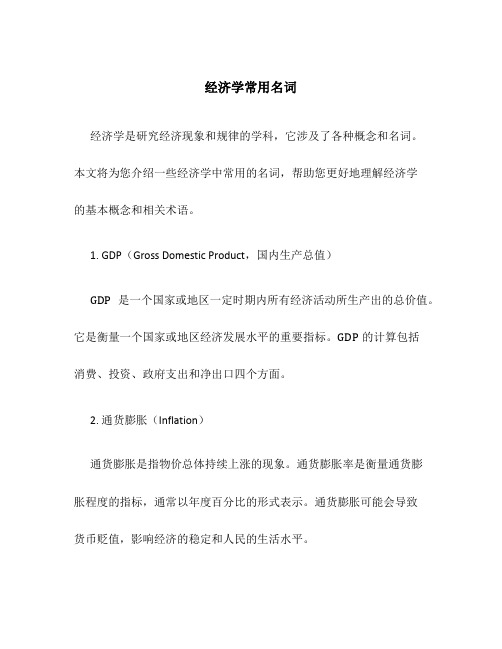
经济学常用名词经济学是研究经济现象和规律的学科,它涉及了各种概念和名词。
本文将为您介绍一些经济学中常用的名词,帮助您更好地理解经济学的基本概念和相关术语。
1. GDP(Gross Domestic Product,国内生产总值)GDP是一个国家或地区一定时期内所有经济活动所生产出的总价值。
它是衡量一个国家或地区经济发展水平的重要指标。
GDP的计算包括消费、投资、政府支出和净出口四个方面。
2. 通货膨胀(Inflation)通货膨胀是指物价总体持续上涨的现象。
通货膨胀率是衡量通货膨胀程度的指标,通常以年度百分比的形式表示。
通货膨胀可能会导致货币贬值,影响经济的稳定和人民的生活水平。
3. 供给与需求(Supply and Demand)供给与需求是经济学中的重要理论基础。
供给指的是生产者愿意提供的商品或服务的数量。
需求则表示消费者愿意购买的商品或服务的数量。
供给与需求的平衡会决定商品或服务的价格和数量。
4. 市场经济(Market Economy)市场经济是一种以市场为基础的经济体制。
在市场经济中,资源的配置由市场机制决定,生产和消费的决策由个人和企业自主作出。
市场的竞争和供求关系起到了调节经济活动的作用。
5. 垄断(Monopoly)垄断是指市场上只有一个唯一的生产者或供应者。
垄断通常会导致价格上涨,消费者的福利减少。
为了维护市场公平竞争,很多国家都对垄断行为进行了法律限制。
6. 失业率(Unemployment Rate)失业率是衡量一个国家或地区劳动力中没有工作的人口比例。
失业率的高低反映了经济的就业状况和劳动力市场的紧张程度。
失业率的控制是政府宏观调控的重要目标之一。
7. 通货紧缩(Deflation)通货紧缩是指物价总体持续下降的现象。
通货紧缩可能会导致消费者延迟购买或减少消费,从而进一步抑制经济增长。
为了防止通货紧缩,通常会采取适当的货币和财政政策。
8. 供给侧改革(Supply-Side Reform)供给侧改革是指通过改革经济结构和优化资源配置来推动经济发展的一种改革思路。
高考经济:常见易混经济术语汇总
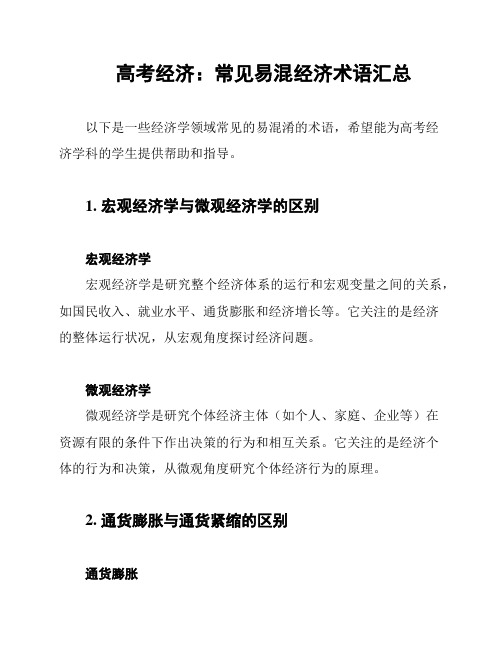
高考经济:常见易混经济术语汇总
以下是一些经济学领域常见的易混淆的术语,希望能为高考经
济学科的学生提供帮助和指导。
1. 宏观经济学与微观经济学的区别
宏观经济学
宏观经济学是研究整个经济体系的运行和宏观变量之间的关系,如国民收入、就业水平、通货膨胀和经济增长等。
它关注的是经济
的整体运行状况,从宏观角度探讨经济问题。
微观经济学
微观经济学是研究个体经济主体(如个人、家庭、企业等)在
资源有限的条件下作出决策的行为和相互关系。
它关注的是经济个
体的行为和决策,从微观角度研究个体经济行为的原理。
2. 通货膨胀与通货紧缩的区别
通货膨胀
通货膨胀指的是货币供应量增加,导致物价总水平普遍上涨的现象。
通货膨胀会降低货币的购买力,造成物价上涨,影响人们的消费和投资决策。
通货紧缩
通货紧缩是指货币供应量减少,导致物价总水平下降的现象。
通货紧缩会提高货币的购买力,导致物价下降,经济活动减弱,企业利润下降,可能引发经济衰退。
3. 贸易顺差与贸易逆差的区别
贸易顺差
贸易顺差是指一个国家在国际贸易中出口商品和服务的价值超过进口的价值。
贸易顺差意味着该国家的外汇收入多于外汇支出,通常被认为是经济增长的积极表现。
贸易逆差
贸易逆差是指一个国家在国际贸易中进口商品和服务的价值超过出口的价值。
贸易逆差意味着该国家的外汇支出多于外汇收入,可能导致国家的外汇储备减少,对经济造成一定的压力。
以上是一些经济学领域容易混淆的术语的简要解释。
希望这份汇总能够对高考经济学科的学生有所帮助。
经济学专业术语(中英文对照)

经济学专业术语(中英文对照)目录1. 经济学原理 (2)2. 像经济学家一样思考 (2)3. 相互依存性与贸易的好处 (3)4. 供给与需求的市场力量 (3)5. 弹性及其应用 (4)6. 供给需求与政策 (4)7. 消费者、生产者与市场效率 (4)8. 赋税的应用 (4)9. 国际贸易 (5)10. 外部性 (5)11. 公共物品和公共资源 (5)12. 税制设计 (5)13. 生产成本 (6)14. 竞争市场上的企业 (7)15. 垄断 (7)16. 垄断竞争 (7)17. 寡头 (7)18. 生产要素市场 (8)19. 收入与歧视 (8)20. 收入不平等与贫困 (8)21. 消费者选择理论 (9)22. 微观经济学前沿 (9)23. 一国收入的衡量 (10)24. 生活费用的衡量 (10)25. 生产与增长 (10)26. 储蓄、投资和金融体系 (11)27. 金融学的基本工具 (11)28. 失业 (12)29. 货币制度 (12)30. 货币增长与通货膨胀 (13)31. 开放经济的宏观经济学 (14)32. 开放经济的宏观经济理论 (14)33. 总需求与总供给 (14)34. 货币政策和财政政策对总需求影响 (15)35. 通胀与失业之间的短期权衡取舍 (15)1.经济学原理经济:(economy)稀缺性:(scarcity)经济学:(economics)效率:(efficiency)平等:(equality)机会成本:(opporyunity cost)理性人:(rational people)边际变动:(marginal change)边际收益:(marginal benefit)边际成本:(marginal cost)激励:(incentive)市场经济:(market economy)产权:(property rights)市场失灵:(market failure)外部性:(externality)市场势力:(market power)生产率:(productivity)通货膨胀:(inflation)经济周期:(business cycle)2.像经济学家一样思考循环流量图:(circular-flow diagram)生产可能性边界:(production possibilities)微观经济学:(microeconomics)宏观经济学:(macroeconomics)实证表述:(positive statements)规范表述:(normative statements)有序数对:(ordered pair)3.相互依存性与贸易的好处绝对优势:(absolute advantage)机会成本:(apportunity cost)比较优势:(comparative advantage)进口品:(imports)出口品:(exports)4.供给与需求的市场力量市场:(market)竞争市场:(competitive market)需求量:(quantity demand)需求定理:(law of demand)需求表:(demand schedule)需求曲线:(demand curve)正常物品:(normal good)低档物品:(inferior good)替代品:(substitutes)互补品:(complements)供给量:(quantity supplied)供给定理:(law of supply)供给表:(supply schedule)供给曲线:(supply curve)均衡:(equilibrium)均衡价格:(equilibrium price)均衡数量:(equilibrium quantity)过剩:(surplus)短缺:(shortage)供求定理:(law of supply and demand)5.弹性及其应用弹性:(elasticity)需求价格弹性:(price elasticity of demand)总收益:(total revenue)需求收入弹性:(income elasticity)需求的交叉价格弹性:(cross-price elasticity)供给价格弹性:(price elasticity of supply)6.供给需求与政策价格上限:(price ceiling)价格下限:(price floor)税收归宿:(tax incidence)7.消费者、生产者与市场效率福利经济学:(welfare economics)支付意愿:(willingness to pay)消费者剩余:(consumer surplus)成本:(cost)生产者剩余:(producer surplus)效率:(efficiency)平等:(equality)8.赋税的应用无谓损失:(deadweight loss)9.国际贸易世界价格:(world price)关税:(tariff)10.外部性外部性:(externality)外部性内在化:(internalizing the externality)矫正税:(corrective taxes)科斯定理:(coase theorem)交易成本:(transaction cost)11.公共物品和公共资源排他性:(excludability)消费中的竞争性:(rivalry in consumption)私人物品:(private goods)公共物品:(public goods)公共资源:(common resources)俱乐部物品:(club goods)搭便车者:(free rider)成本-收益分析:(cost-benefit analysis)公地悲剧:(tragedy of commons)12.税制设计纳税义务:(tax lianility)预算赤字:(budget defict)预算盈余:(budget surplus)平均税率:(average tax rate)边际税率:(marginal tax rate)定额税:(lump-sum tax)受益原则:(benefits principle)支付能力原则:(ability-to-pay principle)纵向平等:(vertical equity)横向平等:(horizontal equity)比例税:(proportional tax)累退税:(regressive tax)累进税:(progressive tax)13.生产成本总收益:(total revenue)总成本:(total cost)利润:(profit)显性成本:(explicit costs)隐性成本:(implicit costs)经济利润:(economic profit)会计利润:(counting profit)生产函数:(production function)边际产量:(marginal product)边际产量递减:(diminishing marginal product)固定成本:(fixed costs)可变成本:(variable costs)平均总成本:(average total cost)平均固定成本:(average fixed costs)平均可变成本:(average variable costs)边际成本:(marginal cost)有效规模:(efficient scale)规模经济:(economies of scale)规模不经济:(diseconomies of scale)规模收益不变:(constant returns to scale) 14.竞争市场上的企业竞争市场:(competitive market)平均收益:(average revenue)边际收益:(marginal revenue)沉没成本:(sunk revenue)15.垄断垄断企业:(monopoly)自然垄断:(natural monopoly)价格歧视:(price discrimination)16.垄断竞争寡头:(oligopoly)垄断竞争:(monopolistic competition) 17.寡头博弈论:(game theory)勾结:(collusion)卡特尔:(cartel)纳什均衡:(Nash equilibrium)囚徒困境:(prisoners’ dilemma)占优策略:(dominant strategy)18.生产要素市场生产要素:(factors of production)生产函数:(production function)劳动的边际产量:(marginal product of labor)边际产量递减:(diminishing marginal product)边际产量值:(value of the marginal product)资本:(capital)19.收入与歧视补偿性工资差别:(compensating differential)人力资本:(human capital)工会:(union)罢工:(strike)效率工资:(efficiency)歧视:(discrimination)20.收入不平等与贫困贫困率:(poverty rate)贫困率:(poverty line)实物转移支付:(in-kind transfers)生命周期:(life cycle)持久收入:(permanent income)功利主义:(utilitariansm)效用:(utilitariansm)自由主义:(liberalism)最大最小准则:(maximin criterion)负所得税:(negative income tax)福利:(welfare)社会保险:(social insurance)自由至上主义:(libertarianism)21.消费者选择理论预算约束线:(budget constraint)无差异曲线:(indiffernnce curve)边际替代率:(marginal rate of subtitution)完全替代品:(perfect substitudes)完全互补品:(perfect complements)正常物品:(normal good)低档物品:(inferior good)收入效应:(income effect)替代效应:(substitution effect)吉芬物品:(Giffen good)22.微观经济学前沿道德风险:(moral hazard)代理人:(agent)委托人:(principal)逆向选择:(adverse selection)发信号:(signaling)筛选:(screening)政治经济学:(political economy)康多塞悖论:(condorcet paradox)阿罗不可能性定理:(Arrow’s impossibility)中值选民定理:(median vater theorem)行为经济学:(behavioral economics)23.一国收入的衡量微观经济学:(microeconomics)宏观经济学:(macroeconomics)国内生产总值:(gross domestic product,GDP)消费:(consumption)投资:(investment)政府购买:(government purchase)净出口:(net export)名义GDP:(nominal GDP)真实GDP:(real GDP)GDP平减指数:(GDP deflator)24.生活费用的衡量消费物价指数:(consumer price index,CPI)通货膨胀率:(inflation rate)生产物价指数:(produer price index,PPI)指数化:(indexation)生活费用津贴:(cost-of-living allowance,COLA)名义利率:(nominal interest rate)25.生产与增长生产率:(productivity)物质资本:(physical capital)人力资本:(human capital)自然资源:(natural resources)技术知识:(technological knoeledge)收益递减:(diminishing returns)追赶效应:(catch-up effect)26.储蓄、投资和金融体系金融体系:(financial system)金融市场:(financial markets)债券:(bond)股票:(stock)金融中介机构:(financial intermediaries)共同基金:(mutual fund)国民储蓄:(national saving)私人储蓄:(private saving)公共储蓄:(public saving)预算盈余:(budget surplus)预算赤字:(budget deficit)可贷资金市场:(market for loanable funds)挤出:(crowding out)27.金融学的基本工具金融学:(finance)现值:(present value)终值:(future value)复利:(compounding)风险厌恶:(risk aversion)多元化:(diversification)企业特有风险:(firm-specific risk)市场风险:(market risk)基本面风险:(fundamental analysis)有效市场假说:(efficient markets by pothesis)信息有效:(informational efficiency)随机游走:(random walk)28.失业劳动力:(laborforce)失业率:(unemployment rate)劳动力参与率:(labor-force participation rate)自然失业率:(natural rate of unemployment)周期性失业:(cyclical unemployment)失去信心的工人:(discouraged workers)摩擦性失业:(frictional unemployment)结构性失业:(structural unemployment)寻找工作:(job search)失业保险:(unemployment insurance)工会:(union)集体谈判:(collective bargaining)罢工:(strike)效率工资:(essiciency wages)29.货币制度货币:(money)交换媒介:(medium of exchange)计价单位:(unit of account)价值储藏手段:(store of value)流动性:(liquidity)商品货币:(commodity money)法定货币:(fiat money)通货:(currency)活期存款:(demand deposits)联邦储备局:(Federal Reserve)中央银行:(central bank)货币供给:(money supply)货币政策:(monetary policy)准备金:(reserves)部分准备金银行:(fractional-reserve banking)准备金率:(reserve ratio)货币乘数:(money multiplier)银行资本:(bank capital)杠杆:(leverage)杠杆率:(leverage ratio)资本需要量:(capital requirement)公开市场操作:(open-market operations)贴现率:(discount rate)法定准备金:(reserve requirements)补充金融计划:(supplementary financing program)联邦基金利率:(federal funds rate)30.货币增长与通货膨胀铲除通胀:(whip Inflation Now)货币数量论:(quantity theory of money)名义变量:(nominal variables)真实变量:(real variables)古典二分法:(classiacl dichotomy)货币中性:(monetary neutrality)货币流通速度:(velocity of money)数量方程式:(quantity equation)通货膨胀税:(inflation tax)费雪效应:(Fisher effect)皮鞋成本:(shoeleather cost)菜单成本:(menu costs)31.开放经济的宏观经济学封闭经济:(closed economy)开放经济:(open economy)出口:(exports)净出口:(net exports)贸易余额:(trade balance)贸易盈余:(trade surplus)贸易平衡:(balanced trade)贸易赤字:(trade deficit)资本净流出:(net capital outflow)名义汇率:(nominal exchange rate)升值:(appreciation)贬值:(depreciation)真实汇率:(real exchange rate)购买力平价:(purchasing-power parity)32.开放经济的宏观经济理论贸易政策:(trade policy)资本外逃:(capital flight)33.总需求与总供给衰退:(recession)萧条:(depression)总需求与总供给模型:(model of aggregate demand and aggregate supply)总需求曲线:(aggregate-demand curve)总供给曲线:(aggregate-supply curve)自然产出水平:(natural level of output)滞胀:(stagflation)34.货币政策和财政政策对总需求影响流动性偏好理论:(theory of liquidity)财政政策:(fisical policy)乘数效应:(multiplier effect)挤出效应:(crowding-out effect)自动稳定器:(automatic stabilizers)35.通胀与失业之间的短期权衡取舍菲利普斯曲线:(phillips curve)自然率假说:(natural-rate hypothesis)供给冲击:(supply shock)牺牲率:(sacrifice ratio)理性预期:(rational expectations)。
高考政治《经济学》答题术语和核心知识点汇总

高考政治《经济学》答题术语和核心知识点汇总经济学是高考政治考试中的重要科目之一。
掌握经济学的答题术语和核心知识点,对于考试取得好成绩至关重要。
以下是经济学的一些重要术语和核心知识点的汇总。
答题术语1. 宏观经济学:研究整个经济系统总体运行规律的经济学分支。
2. 微观经济学:研究经济系统中个体经济单位行为及其相互关系的经济学分支。
3. 劳动力:指用于生产物品和提供服务的人力资源。
4. 预算:指将某一时期内国家或个体的收入和支出计划编制在一起的文件。
5. 价格:指在市场上货币单位能够购买的商品和劳务的数量。
6. 供给:指生产者根据市场价格愿意出售的商品和劳务的数量。
7. 需求:指消费者根据市场价格愿意购买的商品和劳务的数量。
8. 货币:指用作交换媒介和流通手段的特殊商品或代用品。
核心知识点1. 经济体制:指在一定历史条件下,一国或一地区内部经济关系的总和。
2. 国民经济核算:是指对一个国家或地区的经济活动进行多方面统计和综合分析的体系。
3. 经济增长:指一个国家或地区在一定时期内所创造的经济总值和国民生产的规模的扩大。
4. 工业化:是指以工业为主导,工业产值占国民经济总产值比重较高的社会经济发展阶段。
5. 农业现代化:是指以提高农业锄头生产效益和提高农民生活水平为目标,实现农业社会化、商品化的发展方向。
6. 城镇化:是指人口由农村向城市转移和城市化程度提高的过程。
7. 市场经济:国家主要依靠市场机制来调节资源配置和经济行为的一种经济体制。
8. 商品经济:是在一定的社会可交换的价值基础上产生的商品和服务的生产、分配、交换和消费活动。
以上是一些高考政治《经济学》答题术语和核心知识点的汇总。
希望对您的备考有所帮助。
祝您考试顺利,取得好成绩!参考资料:- 高考政治教材- 网上经济学资料。
经济学常用术语及定义

经济学常用术语及定义经济学是研究人类如何管理有限资源的学科。
在经济学中,有许多常用术语和定义。
这些术语和定义帮助我们理解经济学的基本原理和概念。
以下是常用经济学术语和定义的详细介绍。
一、生产要素生产要素是制造或生产物品或服务的资源。
生产要素包括土地、劳动、资本和企业家精神。
1.土地是指全部自然资源,包括土壤,矿产和水资源等。
2.劳动是指人们的劳动力和技能。
3.资本是生产性资产,包括机器、设备和建筑等。
4.企业家精神是指个人或企业家通过发展新产品、新技术或新市场来创造新的商业机会和创新。
二、消费者行为消费者行为是指消费者进行购买决策的过程,包括消费者的需求、偏好和行为。
1.需求是指消费者在特定价格下,想要购买某种物品或服务的数量。
2.偏好是指消费者对商品或服务的特定品质、外观和使用感受的喜好程度。
3.行为是指消费者在购买决策过程中所做的选择和决策。
三、市场和价格市场和价格是经济学中最基本的概念。
市场是指买卖商品或服务的地点,价格是售价或购买价。
1.市场分为商品市场和服务市场。
商品市场是指买卖物品的地点,服务市场是指买卖服务的地点。
2.价格的决定因素包括市场供给和市场需求。
当供给增加时,价格会降低;当需求增加时,价格会提高。
四、成本和效益成本和效益是经济学中用于评估决策的基本原则。
成本是制造或生产物品所用的资源成本,效益是从销售产品或提供服务中获得的利润。
1.成本和效益可以是直接和间接的。
直接成本是指制造或生产物品所用的实际成本,间接成本是指生产物品或提供服务所需要的资源成本,如时间和劳动力。
2.效益是指从销售产品或提供服务中获得的收入。
利润是指从销售产品或提供服务中获得,扣除生产成本后的利润。
五、竞争和垄断竞争和垄断是市场定价的两种不同形式。
竞争市场中,许多企业在一个市场上销售相同的产品或服务。
垄断市场中,一家企业掌握了市场上的垄断地位。
1.竞争市场上,因为存在许多供应商,价格通常比垄断市场上的价格要低。
经济学名词100个

经济学名词100个1、绝对优势(Absolute advantage)如果一个国家用一单位资源生产的某种产品比另一个国家多,那么,这个国家在这种产品的生产上与另一国相比就具有绝对优势。
2、逆向选择(Adverse choice)在此状况下,保险公司发现它们的客户中有太大的一部分来自高风险群体。
3、选择成本(Alternative cost)如果以最好的另一种方式使用的某种资源,它所能生产的价值就是选择成本,也可以称之为机会成本。
4、需求的弧弹性(Arc elasticity of demand)如果P1和Q1分别是价格和需求量的初始值,P2 和Q2 为第二组值,那么,弧弹性就等于-(Q1-Q2)(P1+P2)/(P1-P2)(Q1+Q2)5、非对称的信息(Asymmetric information)在某些市场中,每个参与者拥有的信息并不相同。
例如,在旧车市场上,有关旧车质量的信息,卖者通常要比潜在的买者知道得多。
6、平均成本(Average cost)平均成本是总成本除以产量。
也称为平均总成本。
7、平均固定成本( Average fixed cost)平均固定成本是总固定成本除以产量。
8、平均产品(Average product)平均产品是总产量除以投入品的数量。
9、平均可变成本(Average variable cost)平均可变成本是总可变成本除以产量。
10、投资的β(Beta)β度量的是与投资相联的不可分散的风险。
对于一种股票而言,它表示所有现行股票的收益发生变化时,一种股票的收益会如何敏感地变化。
11、债券收益(Bond yield)债券收益是债券所获得的利率。
12、收支平衡图(Break-even chart)收支平衡图表示一种产品所出售的总数量改变时总收益和总成本是如何变化的。
收支平衡点是为避免损失而必须卖出的最小数量。
13、预算线(Budget line)预算线表示消费者所能购买的商品X和商品Y的数量的全部组合。
常用的经济术语的英文缩写及简要解释
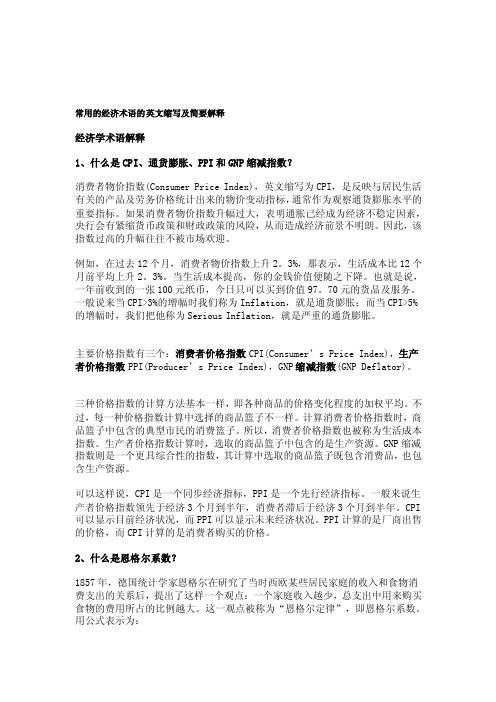
常用的经济术语的英文缩写及简要解释经济学术语解释1、什么是CPI、通货膨胀、PPI和GNP缩减指数?消费者物价指数(Consumer Price Index),英文缩写为CPI,是反映与居民生活有关的产品及劳务价格统计出来的物价变动指标,通常作为观察通货膨胀水平的重要指标。
如果消费者物价指数升幅过大,表明通胀已经成为经济不稳定因素,央行会有紧缩货币政策和财政政策的风险,从而造成经济前景不明朗。
因此,该指数过高的升幅往往不被市场欢迎。
例如,在过去12个月,消费者物价指数上升2。
3%,那表示,生活成本比12个月前平均上升2。
3%。
当生活成本提高,你的金钱价值便随之下降。
也就是说,一年前收到的一张100元纸币,今日只可以买到价值97。
70元的货品及服务。
一般说来当CPI>3%的增幅时我们称为Inflation,就是通货膨胀;而当CPI>5%的增幅时,我们把他称为Serious Inflation,就是严重的通货膨胀。
主要价格指数有三个:消费者价格指数CPI(Consumer’s Price Index),生产者价格指数PPI(Producer’s Price Index),GNP缩减指数(GNP Deflator)。
三种价格指数的计算方法基本一样,即各种商品的价格变化程度的加权平均。
不过,每一种价格指数计算中选择的商品篮子不一样。
计算消费者价格指数时,商品篮子中包含的典型市民的消费篮子。
所以,消费者价格指数也被称为生活成本指数。
生产者价格指数计算时,选取的商品篮子中包含的是生产资源。
GNP缩减指数则是一个更具综合性的指数,其计算中选取的商品篮子既包含消费品,也包含生产资源。
可以这样说,CPI是一个同步经济指标,PPI是一个先行经济指标。
一般来说生产者价格指数领先于经济3个月到半年,消费者滞后于经济3个月到半年。
CPI 可以显示目前经济状况,而PPI可以显示未来经济状况。
PPI计算的是厂商出售的价格,而CPI计算的是消费者购买的价格。
经济学术语

逆全球化,即与全球化进程背道而驰,重新赋权于地方和国家层面的 思潮。
2017年3月5日,总理在第十二届全国人大第五次会议上所做的政府工 作报告中,逆全球化被着重提及。指出,要“推进一带一路建设,与沿线 国家加强战略对接、务实合作”。“一带一路”是中国对“逆全球化”倾 向开出的一剂良方。
近日,在由国际经济交流中心和新华社国家高端智库联合举办的“全 球不确定条件下的亚洲经济前景”研讨会上,中华人民共和国商务部原副 部长魏建国表示,特朗普上任以来,亚洲经济面临的全球不确定风险越来 越大,持这种观点的不仅有东盟国家的一些领导人,还包括中国香港、澳 门和台湾地区的领导人,以及亚洲一些主要以营销进出口商品为主的企业 家,他们将当前的不确定形势称为逆全球化。
企业契约是公司之间的约定的方式。
Jensen和Meckling(1976)认为企业是各种生产要素所有者之间以及 他们和顾客之间的一系列契约的集合,这些契约既可以是书面签订的也可 以不是。在市场上既存在着产品的供应方和需求方,也存在着生产要素的 供应方和需求方,而某项最终产品从原材料的购买到最终产品的销售直至 顾客的消费需要一个相当长的过程。在市场上这一过程可能需要一系列连 续的交易环节才能完成然而市场上的交易并不是没有成本的,最明显的成 本是时间成本。交易环节的增多必然会增加产品生产过程的时间,进而增 加产品的成本,无形中浪费了宝贵的资源。因此企业这一组织形式是作为 一种节约资源促送资源更高效流通的工具出现的,它是对市场功能的有益 补充。
企业这一组织形式以契约的方式将企业的各契约方绑在了同一艘船上, 对于这艘船而言,它是顺利前行还是不幸沉没,先直接关系到船上所有人 员的利益。虽然说契约各方在一定程度上拥有共同的权利和义务,要承受 某些共同的风险。
短期生产函数是指在短期内至少有一种投入要素使用量不能改变的生 产函数。在短期内,假设资本数量不变,只有劳动可随产量变化,则生产 函数可表示为Q=f(L),这种生产函数可称为短期生产函数。微观经济学通 常以一种可变生产要素的生产函数考察短期生产理论,以两种可变生产要 素的生产函数考察长期生产理论。
经济学常用术语

经济学常用术语1、什么是CPI、通货膨胀、PPI消费者物价指数(Consumer Price Index),英文缩写为CPI,是反映与居民生活有关的产品及劳务价格统计出来的物价变动指标,通常作为观察通货膨胀水平的重要指标。
如果消费者物价指数升幅过大,表明通胀已经成为经济不稳定因素,央行会有紧缩货币政策和财政政策的风险,从而造成经济前景不明朗。
因此,该指数过高的升幅往往不被市场欢迎。
例如,在过去12个月,消费者物价指数上升2.5%,那表示,生活成本比12个月前平均上升2.5%。
当生活成本提高,你的金钱价值便随之下降。
也就是说,一年前收到的一张100元纸币,今日只可以买到价值97.50元的货品及服务。
一般说来当CPI>3%的增幅时,就是通货膨胀;而当CPI>5%的增幅时,就是严重的通货膨胀。
主要价格指数有:消费者价格指数CPI(Consumer’s Price Index),生产者价格指数PPI(Producer’s Price Index)。
两种价格指数的计算方法基本一样,即各种商品的价格变化程度的加权平均。
不过,每一种价格指数计算中选择的商品篮子不一样。
计算消费者价格指数时,商品篮子中包含的典型市民的消费篮子。
所以,消费者价格指数也被称为生活成本指数。
生产者价格指数计算时,选取的商品篮子中包含的是生产资源。
可以这样说,CPI是一个同步经济指标,PPI是一个先行经济指标。
一般来说生产者价格指数领先于经济3个月到半年,消费者滞后于经济3个月到半年。
CPI可以显示目前经济状况,而PPI可以显示未来经济状况。
PPI计算的是厂商出售的价格,而CPI计算的是消费者购买的价格。
3、什么是GDP?什么是GNP?二者有什么区别?GDP即英文“Gross Domestic Product”的缩写,也就是国内生产总值。
它是对一国(地区)经济在核算期内所有常住单位生产的最终产品总量的度量,常常被看成显示一个国家(地区)经济状况的一个重要指标。
常用的经济学术语
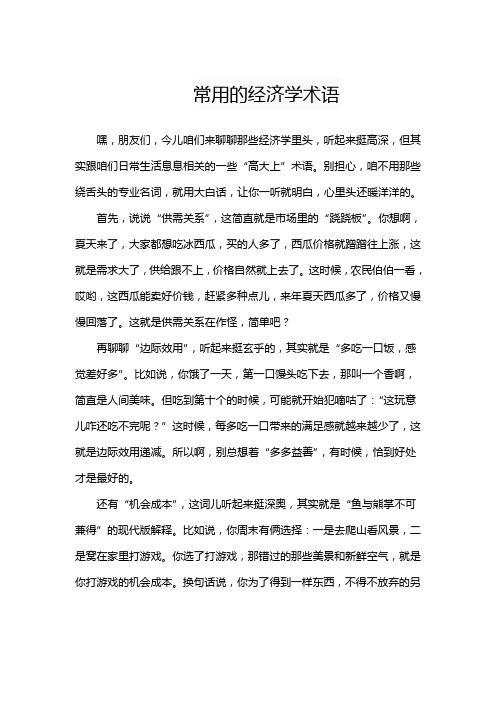
常用的经济学术语嘿,朋友们,今儿咱们来聊聊那些经济学里头,听起来挺高深,但其实跟咱们日常生活息息相关的一些“高大上”术语。
别担心,咱不用那些绕舌头的专业名词,就用大白话,让你一听就明白,心里头还暖洋洋的。
首先,说说“供需关系”,这简直就是市场里的“跷跷板”。
你想啊,夏天来了,大家都想吃冰西瓜,买的人多了,西瓜价格就蹭蹭往上涨,这就是需求大了,供给跟不上,价格自然就上去了。
这时候,农民伯伯一看,哎哟,这西瓜能卖好价钱,赶紧多种点儿,来年夏天西瓜多了,价格又慢慢回落了。
这就是供需关系在作怪,简单吧?再聊聊“边际效用”,听起来挺玄乎的,其实就是“多吃一口饭,感觉差好多”。
比如说,你饿了一天,第一口馒头吃下去,那叫一个香啊,简直是人间美味。
但吃到第十个的时候,可能就开始犯嘀咕了:“这玩意儿咋还吃不完呢?”这时候,每多吃一口带来的满足感就越来越少了,这就是边际效用递减。
所以啊,别总想着“多多益善”,有时候,恰到好处才是最好的。
还有“机会成本”,这词儿听起来挺深奥,其实就是“鱼与熊掌不可兼得”的现代版解释。
比如说,你周末有俩选择:一是去爬山看风景,二是窝在家里打游戏。
你选了打游戏,那错过的那些美景和新鲜空气,就是你打游戏的机会成本。
换句话说,你为了得到一样东西,不得不放弃的另一些东西的价值,就是机会成本。
下次做决定前,不妨想想这个机会成本,看看值不值得。
说到“通货膨胀”,很多人第一反应就是钱不值钱了。
其实呢,它就像是咱们身上的衣服,年年都得换新,因为物价在涨啊。
想当年,一块钱能买一大堆糖果,现在可能只能买两颗了。
这就是通货膨胀在悄悄作祟,它让钱的价值变小了。
不过别担心,国家有招儿对付它,比如调整利率啊、控制货币供应啊之类的,都是为了让咱们的钱袋子更鼓一些。
最后说说“经济周期”,这就像是大自然的四季更替一样,经济也有它的起起落落。
有时候经济火热得跟夏天一样,大家都忙着赚钱;有时候又冷清得跟冬天似的,找工作都难。
经济学相关名词解释

经济学相关名词1、GDP:国内生产总值(Gross Domesti c Product,简称GDP)国内生产总值是指在一定时期内(一个季度或一年),一个国家或地区的经济中所生产出的全部最终产品和劳务的价值,常被公认为衡量国家经济状况的最佳指标。
它不但可反映一个国家的经济表现,更可以反映一国的国力与财富。
一般来说,国内生产总值共有四个不同的组成部分,其中包括消费、私人投资、政府支出和净出口额。
用公式表示为:GDP = CA + I + CB + X 式中:CA为消费、I为私人投资、CB为政府支出、X为净出口额。
2、GNP:GNP(Gross Nationa l Product)是指一个国家(或地区)所有国民在一定时期内新生产的产品和服务价值的总和。
GNP与GDP的关系是:GNP等于GD P加上本国投在国外的资本和劳务的收入再减去外国投在本国的资本和劳务的收入。
3、马太效应:马太效应(Matthew Effect),是指好的愈好,坏的愈坏,多的愈多,少的愈少的一种现象。
在《圣经·新约》的“马太福音”第二十五章中有这么说道:“凡有的,还要加给他叫他多余;没有的,连他所有的也要夺过来。
”社会学家从中引申出了“马太效应”这一概念,用以描述社会生活领域中普遍存在的两极分化现象。
罗伯特·莫顿归纳“马太效应”为:任何个体、群体或地区,一旦在某一个方面(如金钱、名誉、地位等)获得成功和进步,就会产生一种积累优势,就会有更多的机会取得更大的成功和进步。
此术语后为经济学界所借用,反映贫者愈贫,富者愈富,赢家通吃的经济学中收入分配不公的现象。
4、二八定律:二八定律也叫巴莱多定律,是19世纪末20世纪初意大利经济学家巴莱多发明的。
他认为,在任何一组东西中,最重要的只占其中一小部分,约20%,其余80%的尽管是多数,却是次要的,因此又称二八法则。
- 1、下载文档前请自行甄别文档内容的完整性,平台不提供额外的编辑、内容补充、找答案等附加服务。
- 2、"仅部分预览"的文档,不可在线预览部分如存在完整性等问题,可反馈申请退款(可完整预览的文档不适用该条件!)。
- 3、如文档侵犯您的权益,请联系客服反馈,我们会尽快为您处理(人工客服工作时间:9:00-18:30)。
经济学术语经济学术语可能是非常复杂的。
这有213个在经济学杂志中最常见的经济学术语,也是经济学家最常用的语言之一。
如果你掌握了这些术语,将会帮助你加强对经济学的了解。
A ,B ,C ,D ,E ,F ,G ,H ,I ,J ,K ,L ,M ,N ,O ,P ,Q ,R ,S ,T ,U ,V ,W ,X ,Y , ZAAbsolute Advantage :The ability of a producer to produce a higher absolute quantity of a good with the productive resource available.Abundance :A term that applies when individuals can obtain all the goods they wantwithout cost. If a good is abundant, it is free.Accelerator :The casual relationship between changes in consumption and changes ininvestment.Activist Fiscal Policy :Use of the federal governments taxing, spending and borrowing powers inorder to stimulate economic growth and employment.Actual Turnover :The number of times individuals actually spend their average money holding over a given period of time. Actual turnover is determined by theproportion of income that people receive and actually retain as moneybalances over a given period of time.Antitrust Laws :Designed to promote open markets by limiting practices that reducecompetition.Assets :What a person or business owns.Automatic Stabilizers :Measures built into the governments budget that cause its spending toincrease and its tax revenues to decrease when the economy goes intoslumps, and that cause government expenditures to decrease and taxes toincrease when the economy goes into booms.BBalance of Payments :A record of all the financial transactions between a country and the rest of the world during a given year.Bank Reserves :The total quantity of Federal Reserve notes held in bank vaults orcheckable deposits held by the banks at the Fed district banks.Benefits in Kind :Noncash forms of pay or assistance.Bracket Creep :The process by which inflation drives personal incomes upward into higher tax brackets :in a progressive income tax system, this causes an increase in tax burdens.Bretton Woods :An international monetary system operating from 1946-1973. The value of thedollar was fixed in terms of gold, and every other country held itscurrency at a fixed exchange rate against the dollar; when trade deficits occurred, the central bank of the deficit country financed the deficit with its reserves of international currencies.Business Cycles :Periodic swings in the pace of national economic activity, characterized by alternating expansion and contraction phases.CCapital :The existing stock of productive resources, such as machines and buildings, that have been produced. Capital Intensive :Production methods with a high quantity of capital per worker.Capitalist Economies :Economies which use market-determined prices to guide peoples choices about the production and distribution of goods; these economies generally haveproductive resource which are privately owned.Central Bank Intervention :Influence on exchange rates in the foreign exchange market when exchangerates are not fixed by law; i.e., a central bank buys its countrys currency with foreign currencies to drive its currency up in value; to drive itdown, a central bank sells its currencies in return for foreign currencies.Change in Demand :A shift in the entire demand curve so that at any given price, people will want to buy a different amount. A change in demand is caused by some change other than a change in the goods price.Change in Quantity Demanded :Movement up or down a given demand curve caused by a change in the goodsprice with no shift in the curve itself.Change in Quantity Supplied :A price change causing movement along the supply curve but no shift in the position of the curve itself.Change in Supply :A change in one of the cost determinants of supply causing a shift in the position of the supply curve. Choice :The act of selecting among alternatives, a concept crucial to economics.Civilian Labor Force :All persons over the age of sixteen who are not in the armed forces norinstitutionalized and who are either employed or unemployed.Common Property Resources :Resources for which there are no clearly defined property rights; property owned in common by a society. Comparative Advantage :The ability of a producer to produce a good at a lower marginal cost than other producers; marginal cost in the sacrifice of some other good compared to the amount of a good obtained.Competition :Rivalry among individuals in order to acquire more of something that isscarce.Complements :A price change for one product leads to a shift in the opposite direction direction in the demand for another product.Comprehensive Employment and Training Act (CETA) :Federal funding for local governments to retrain and employdifficult-to-hire workers.Consumer Price Index (CPI) :A measure of the average amount (price) paid for a market basket of goods and services by a typical U.S. consumer in comparison to the average paid for the same basket in an earlier base year.Consumption Expenditures :The total dollar value of all goods and services purchased by the household sector for current use.Consumption Function :A mathematical expression relating personal consumption expenditures todisposable income.Contraction Phase :The part of the business cycle when GNP, employment and production are on the decline.Corn Laws :Tariffs which England placed on grain imports from 1815 to 1846. Byrestricting the supply or grain in England, these laws raised the price of grain in England and increased the value of English farmland.Cost :The most valuable opportunity forsaken when a choice is made.Cost-of-Living Adjustments :Automatic adjustments in incomes paid to individual recipients which aretied to the inflation rate, usually measured by the Consumer Price Index.Cost-Push Inflation :A term that applies when increases in the price level are caused byincreases in cost.Council of Economic Advisors :Three persons who act as the Presidents chief economic advisers.Craft Unions :Exclusive combinations of workers in individual trades such as printers,shoemakers and bakers.Credit :The capacity to borrow money up to a specified limit under specifiedconditions.Crowding In :Increase of private investment through the income-raising effect ofgovernment spending financed by deficits.Crowding Out :The tendency for federal government, by deficit financing to compete with firms or persons for borrowed funds; that is, firms and households unable to borrow at a low rate of interest curtail their investment andconsumption spending.Currency :Paper money issued by the government.Current Account :Acategory in the balance of payments account that includes all transactions that either contribute to national income or involve the spending ofnational income.Cyclical Unemployment :Temporary layoff of workers due to downturns in the pace of economicactivity.DDeficit Spending :A term which refers to the situation wherein he government spends more than it receives in taxes.Demand :The maximum quantities of some good that people will choose (or buy) atdifferent prices. An identical definition is the relative value of themarginal unit of some good when different quantities of that good areavailable.Demand Curve :A graphic representation of the relationship between prices and thecorresponding quantities demanded per time period.Demand Deposits :Checking accounts in commercial banks. These banks are obliged to pay out funds when depositors write checks on those numbers. Checking accounts are not cash - they are numbers recorded in banks.Demand-Pull Inflation :A term used when an increase in aggregate demand occurs which cannot beoffset by a corresponding increase in real supply causing an increase inthe price level (inflation).Diminishing Relative Value :The principle that if all other factors remain constant, and individualsrelative value of a good will decline as more of that good is obtained.Accordingly, the relative value of a good will increase, other factorsremaining constant, as an individual gives up more of that good.Diminishing Returns :As more and more of a productive resource is added to a given amount to other productive resources, additions to output will eventually diminish other factors, such as technology and the degree of specializationremaining constant.Discount Rate :The interest a private bank pays for a loan from the U.S. Federal Reserve System.Discretionary Fiscal Policy :Changes in a fiscal (tax or spending) program initiated by the government in order to change aggregate demand.Disequalibrium :The quantity demanded does not equal the quantity supplied at the going price.Disinflation :A slowdown in the rate of inflation.Disposable Income :The amount of an individuals income that remains after the deduction of income taxes.Dividends :Profits of a firm that are distributed to its investors (stockholders).Division of Labor :Assigning of specific tasks to workers and productive resources; it is a reflection of economic specialization.EEconomic Growth :A sustained increase in total output or output per person for an economyover a long period of time.Economic Recovery Tax Act of 1981 (ERTA) :Designed to foster savings and investment to encourage long-term growththrough reductions of personal income tax rates, taxes on personal savings for retirement and business taxes for firms investing in new capital.Economic Regulations :The control of entry into the market, pricing, the extension of service by established firms and issues of quality control.Economic Specialization :Concentration of activity in a few particular tasks or in producing only a few items.Economics :The study of choice and decision-making in a world with limited resources.Efficiency :The allocation of goods to their uses of highest relative value.Elasticity of Demand :The percentage change in the quantity demanded divided by the percentagechange in price.Embargo :A deliberate cutoff of supply, typically intended as a political statement.Employment Act of 1946 :Set full employment and price stability as national policy goals andestablished the Council of Economic Advisors.Entitlements :Government transfer payments made to individuals having certain designated characteristics and circumstances, such as age or need.Equation of Exchange (M x T = P x Q) :The equation indicates that the money supply multiplied by the number of times that money turns over equals the price level multiplied by realoutput.Equilibrium :The amount of output supplied equals the amount demanded. At equilibrium, the market has neither a tendency to rise nor fall but clears at theexisting price.Exchange :The voluntary transfer of rights to use goods.Exchange Rate :The price of one currency in terms of another.Exchange Value :The purchasing power of a unit of currency for goods and services in the marketplace.Exclusion Principle :The owner of a private good may exclude others from use unless they pay.Expansion Phase :The phase of the business cycle when the economy is growing rapidly :output is increasing, employment is rising, industrial production isincreasing and prices are tending to rise.Externalities :Costs or benefits that fall on third parties.FFederal Debt :The current dollar sum of obligations equal to the accumulated pastdeficits minus surpluses of the United States government.Federal Deposit Insurance Corporation (FDIC) :A federal regulatory agency that insures all deposit accounts in memberbanks up to $100,000.Federal Reserve System :The U.S. central bank consisting of 12 regional banks are run by a board of governors appointed by the president for overlapping 14-year terms;formally independent of the executive and congressional branches ofgovernment; private bank members of the system own their assets.Fiscal Policy :Those federal-government expenditure, tax and borrowing decisions thataffect the level of national economic activity.Fisher Effect :An increase in expected inflation causes a proportional increase in themarket interest rate so that the expected real rate of interest remainsunchanged.Fixed Exchange Rates :The central bank holds the value of the currency constant against someforeign currency or currencies.Fixed Inputs :Inputs that cannot be changed over a given time interval.Floating Exchange Rates :The central bank allows market supply and demand to determine currencyexchange rates. Foreign Currency Reserve :The foreign currencies that a central bank keeps on hand for intervention.Free Good :A good which is abundant and costless.Free Rider :One who receives something without paying.Frictional Unemployment :Unemployment due to workers leaving old jobs and seeking new ones.Friedmans Law :Inflation follows excessive monetary growth with a long (about two years) and variable lag :or the rate of price change follows the rate of monetary growth.GGains of Exchange :The difference between the relative values of a good to the buyer and theseller. How this difference is divided between buyer and seller will depend upon the price of the good. Exchange will not occur unless both the buyer and the seller expect to receive some of this gain.GNP Deflator :Measure of the percentage increase in the average price of products in GNP over a certain base year (now 1972) published by the Commerce Department.Good :Anything that anyone wants. All options or alternatives are goods. Goodscan be tangible or intangible.Government Budget Constraint :Total government outlays (the sum of expenditures on goods and services,transfer payments and interest on debt) must equal total revenue (the sum of taxes and U.S. government loans).Government Security :A contract of the government promising to pay a lender a fixed rate ofinterest per year and repay the original loan at a fixed future date.Government Transfer Payment :Outlays by the government for which no good or service is received in the current period.Gross National Product (GNP) :The total market value, in terms of current dollars, of all final goods and services produced in the U.S. in one year.HHyperinflations :Rapid, out-of-control inflations, at double digit rates per month and more,usually occurring only during wars and periods of severe politicalinstability.IIncome Policies :Strategies to restrict wage and price increases, ranging from "jawboning" by the president to laws that set wage and price levels.Income Statement :An annual summary of income and expenses of a given business in order todetermine the net income of the business.Income Velocity of Money :The ratio of national income to the quantity of money in circulation;velocity measures the average number of times money changes hands ingenerating national income per year (monetarist theory).Inelastic Demand :A term used when the percentage change in quantity demanded is smaller than the percentage change in price.Indexation :Modifying contracts so that their dollar terms adjust to the inflation rate as measured in an index, such as the consumer price index.Inflation :Increase in the overall level of prices over an extended period of time.Interest :The annual earnings that are sacrificed when wealth is invested in a given asset or business. The interest sacrificed by investing in a given business is often called the cost of capital.International Monetary Fund (IMF) :The overseer for the exchange rate system and international monetaryrelations.Inventory :A stock of goods or resources held by a buyer or seller in order to reduce the cost of exchange or production.Investment Expenditures :Dollar expenditures by firms on capital goods (factories, office buildings and others structures, machinery and equipment, inventories and residential housing) used to produce other new goods and services.Involuntary Unemployment :Potential workers able and willing to work at the existing market wagerate, are unable to find jobs.JKKeynesians :A group of economists who emphasize an activist governmental role ineconomic affairs through planned changes in the federal governmentsexpenditures and taxes.LLabor Intensive Methods :Use of low quantity of capital per worker.Labor Productivity :The ratio of real output per unit of labor input; growth is measured by a higher ratio of outputs to inputs.Large Econometric Models :Mathematical constructions of national economics used for policy analysis and forecasting.Law of Demand :People purchase more of any particular good or service as its relativeprice falls; they purchase less as its relative price rises.Law of Supply :At higher relative prices, the quantity supplied of a good will increase; at lower relative prices, smaller quantities will be supplied.Legal Tender :Paper dollars and coins mandated as acceptable means of payment by thegovernment.Leisure :All uses of time in which ones labor services are not exchanged for money. The uses of everyones time can be divided between employment and leisure.Liabilities :The debts of a person or business.Libertarianism :The view that governments role should be minimal, rarely interfering in the personal lives of private citizens.Lorenz Curve :A graph which visually presents a measure of the inequality of a nationsincome distribution.MM1 :The total quantity of coins and paper currency classified as legal tender by government mandate that circulates in the hands of the public, plus all checking account balances the public maintains in financial institutions.M2 :All of M1 plus savings, small time deposit account balances (less than$100,000) in financial institutions and small money market mutual fundsowned by individuals.Macroeconomics :The study of the sum total of economic activity, dealing with the issues of growth, inflation0 and unemployment and with national economic policiesrelating to these issues. Malthusian Trap :The minimum subsistence level to which humans descend as a result ofgeometric population growth and arithmetic resource growth.Managed Floating :Intervention by central banks in foreign exchange markets to stabilizetheir currency exchange rates.Marginal :The additional or extra quantity of something. If one drinks six sodas in a day, the marginal soda would be the sixth soda.Marginal Cost :The increase in total costs as one more unit is produced.Marginal Productivity :The additional output obtained by adding an additional unit of a productive resource, such as labor. More precisely, marginal productivity is thechange in total output divided by the change in the amount of theproductive resource employed.marginal productivity = change in total output change in amount ofproductive resourceMarginal Propensity to Consume (MPC) :The percentage of new or added income that is consumed.Marginal Propensity to Save (MPS) :The percentage of new or added income that is saved.Marginal Revenue :The addition to total revenue as one additional unit is produced and sold.Marginal Tax Rate :The tax rate charged on the taxpayers last dollar earned; in a progressive tax system the marginal tax rate is always greater than the average taxrate.Market :A network in which buyers and sellers interact to exchange goods andservices for money.Market Clearing Price :A price which rations the supply of a good among competing consumers sothat the quantity of the good demanded is equal to the quantity supplied.Market Economy :A decentralized system where many buyers and sellers interact.Merchandise Trade Balance :Category in the current account of the balance of payments which includes all traded goods (manufactured items, agricultural commodities, chemicals and all other physically tangible products).Microeconomics :The study of the individual parts of the economy, the household and thefirm, how prices are determined and how prices determine the production, distribution and use of goods and services.Minimum Wage :A wage below which employers may not legally pay employees for specifickinds of employment.Monetarists :Followers of Milton Friedman who focus on the effect of money and monetary policy on changing price and employment levels.Monetary Base :The total quantity of currency in circulation outside of banks plus thecurrency held by banks or deposited with the Fed.Monetary Policy :The federal governments attempt to change aggregate demand through money supply changes.Money :The accepted common medium of exchange for goods and services in themarketplace that functions as the unit of account, a means of deferredpayment and a store of value.Money Market Mutual Funds :Shares in institutional funds invested in financial instruments such as the U.S. Treasury securities, certificates of deposit in financial institutions (CDs) and commercial paper (IOUs of big corporations). Money Multiplier :The process by which excess reserves create new demand deposits or money; for example, with a 10% legal reserve requirement, $10 of excess reserves may be used to create $100 of new money.Money Supply :Legal currency and various transaction account balances held at financial institutions (M1) plus small savings and time deposit accounts ofindividuals (M2).Monopolistic Competition :A market with a large number of firms selling similar but differentiatedproducts with no significant barriers to entry.Monopoly :A market with only one supplier.Multiplier :The number of times new investment spending will be respent to produce acertain amount of new income.NNatural Monopoly :One producer supplying all of the market at lower costs than many producers could.Natural Unemployment Rate :An economys civilian unemployment rate when supply and demand for labor are equal. The natural rate is the percentage of the civilian labor forceunemployed at one time or another during any given year multiplied by theaverage time people spend searching for jobs.Near-Monies :Assets which are not directly exchangeable for goods and services but which may be readily converted into money. A savings account is an example.Need :A specific quantity of a specific good for which an individual would payany price.Net Worth :The difference between the assets and liabilities of a person or business. New Classical Macroeconomics :See Supply-Side Economics.New Deal :Programs initiated in the 1930s that were characterized by significantlyincreased government aid to various economic groups and equally significant increases in government involvement in the economy.Nominal GNP :GNPmeasured in current prices (see Real GNP).Nominal Interest Rate :The cost inflicted by inflation eroding the value of stored dollars plusthe forgone real interest rate; the opportunity cost of holding money.Normative Economics :Analysis that contains value judgments, either implicitly or explicitly(see Economics or Positive Economics).OOligopoly :A market structure with just a few firms controlling a high percentage of total sales.Open Market Operations :The purchase or sale of government bonds by the Federal Reserve in order to change commercial banks reserves.Opportunity Cost :The highest-valued sacrifice needed to get a good or service.Option :Anything that anyone wants. In economics, options (alternatives) are also called goods.Organization of Petroleum Exporting Countries (OPEC) :A group of nations that produce most of the worlds oil and control most of the worlds oil exports.PParadox of Thrift :Increased saving increases withdrawals from the money flow; unless thesewithdrawals are successfully channeled into new investment spending,capital formation will decline.Peak :The highest point attained in the business cycle.Personal Saving :The difference between household income (after taxes) and consumptionexpenditures.Political Economy :Policies that emphasize the interaction between politics and economics and that have political and economic effects.Price :The amount of money, or other goods, that you have to give up to buy a good or service.Price Ceiling :The upper legal limit on a price.Price Elasticity of Demand :A measure of the responsiveness of the quantity demanded of a good tochanges in that goods price.Price Floor :The lower limit imposed on a products price by a price control law.Private Good :A good exclusively owned that cannot be simultaneously used by others.Production Possibilities Curve :All combinations of the maximum amounts of goods that a society can produce with the available resources and technology.Productive Resources :The inputs of labor, natural resources and capital used to generate newgoods and services.Profits :The excess of income over all costs, including the interest cost of thewealth invested. The net income of a business is not an accurate measure of its profit.Property Rights :The conditions of ownership of an asset, the rights to own, use and sell.Public Goods :Goods that cannot be withheld from people even if they dont pay for them.Pure Competition :A situation where many sellers sell the same product and no seller can set the price.QQuota :A quantitative restriction on imports.RRational Expectations :Market participants intuitively anticipate systemic policy actions andtheir consequences for the economy; thus, on average, private marketforecasts are accurate and planned policy is ineffectual (see New Classical Macroeconomics).Real GNP :The GNP of any year measured in the prices of a base year. Real GNP isnominal GNP adjusted for inflation.Real Rate of Interest :The dollar interest rate corrected for inflation; equal to the nominal rate minus the inflation rate.Real Wage :Ones wage adjusted for inflation.Regressive Taxes :A greater portion of income is taken from those in lower levels than from those in upper income levels.Rent Controls :Fixed limits on rents that can be charged to tenants by owners according to a legal restriction. Retained Earnings :Business profits which are held by firms and not paid to the stockholders of the firm; the earnings are usually reinvested by the firms.Revenues :Total gross earnings of a firm before subtracting costs.Right-to-Work Laws :Laws banning union membership as a requirement for continued employment.SScarce Good :A good which people want more of and which is costly to obtain.Scarcity Shortage :A term used when the quantity of a good demanded exceeds the quantitysupplied at the existing price.。
